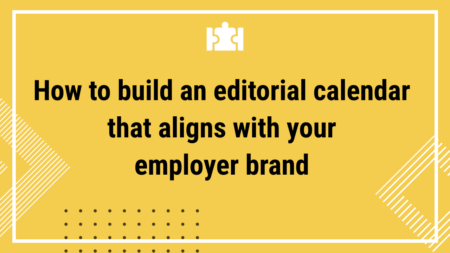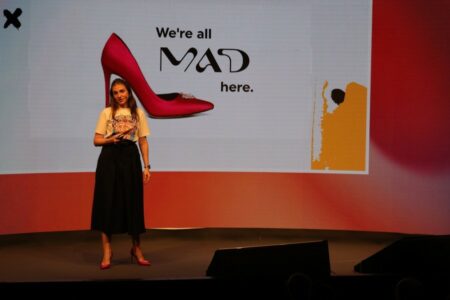What is “employer branding” and why does it matter? Employer branding can be broken down into two core steps: first, the focus should be on making your company an ideal workplace. Second, let everyone know how amazing it is to work for your company. Before getting started, the question one should have in mind is this one: If I were to look for a job today, would I want to work for my company?
We live in a world of digitalization; a world where a company’s reputation is exposed and discussed on review websites like Glassdoor, Indeed or Comparably. Social media is yet another place where people turn to prior to applying for a job. In the simplest terms, an employer brand can be described as a company’s unique appeal; the thing that sets it apart from the competition. Some call it the “essence” of a company and its ability to promote that essence to a targeted group of job seekers that they wish to hire.

Why does employer branding matter so much? The quick answer is this one: because the competition is killing you and you need a hiring strategy that speaks louder than Christmas bonuses. Whatever your niche, your industry, your size, your mission, it is important to have a distinct “voice” for people to have an interest. Did you know that 90% of job seekers consider transparency a core company characteristic? So where do they go to check that out? We place our bet on social media.
Globally there are more than 3 billion social media users; an indicator that pushes companies to shift from an offline-first approach to an online-first strategy when communicating with their target audience. An appealing brand works miracles when the goal is to recruit the right people. In fact, 75% of job seekers have said that they check out a company’s presence online prior to applying.
Having a killer online presence matters more now than ever. You can’t afford the negative feedback because once it sabotages your hiring efforts, retaining top talent becomes almost impossible. A study done by TalentNow pointed out that 55% of job seekers ditch job applications if they come across negative company reviews. What’s worse is that only 45% of HR managers monitor negative reviews in an attempt to fix things.
Before we get into the nitty-gritty of attracting and retaining top talent with the finest employer branding strategy on Earth, let us have a look at some of the benefits of employer branding for business.
Benefits of employer branding for your business
Now that you’ve gotten some idea of what employer branding is, let us tackle some of the core benefits for your business. Why should you develop an employer brand?
Lower cost per hire
The stronger your employer brand is the greater the chances you have, as a business, to foster a productive work environment. As your brand maintains a good reputation, candidates will be drawn to your core values. In time, you’ll devote less time to creating brand awareness, saving money.
The employees you already have will maintain a strong company image while also contributing to maintaining the brand appeal. With 75% of job seekers analyzing a brand prior to applying to a job, companies that consider employer branding important have seen a reduction in cost-per-hire of 50% (LinkedIn).
Faster hire time
A well-crafted employer branding strategy paves the way for attracting and retaining top talent a lot faster. A larger pool of applicants implies that you’ll spend less time hunting for suitable candidates. From a sales perspective, inbound leads convert better than cold calls; for talent acquisition, it’s exactly the same thing.
The more you work to build your employer brand the better chances you have to appear trustworthy, interesting, different in the eyes of your applicants.
Increased brand likability
Developing a dynamic employer brand that resonates with your top employees will have a great impact on applicants, too. It enables you to portray a sense of who you are as an employer, what makes you the best company to work for, what it’s like to work for your company and how you value your employees.
Leaving aside the benefits and importance of having a strong employer brand, in the lines below we will go more in-depth into how you can build your employer brand from scratch to attract and retain top talent.
Evaluate current employer brand & craft an EVP
Prior to getting started, your company needs a clearly-defined EVP (employer value proposition). In simple terms, an EVP is defined as a collection of rewards – both financial and non-financial – that benefit your employees. The purpose is attract, retain, as well as motivate them to do their job. An EVP oriented at potential candidates can be described as “a set of core perks” that make your company attractive; a complete package of well-crafted reasons that persuade job seekers to apply for a position in your company.
To make sure that you attract the best of the best, it is important to define how you stand above the competition, too. Common perks include a competitive salary package, excellent health insurance, a flexible working schedule, a nice workspace; all in all, a company culture that values people.
Craft an employee engagement survey (audit)
“Companies with highly engaged staff outperform their peers by 147% in earnings per share.” (Gallup) Even more so, when a company successfully engages both its staff and customers they experience a 240% boost in performance-related business outcomes. By measuring their level of engagement and tackling pain points, you’ll find out how your own people perceive you as a brand. This will help you determine both strengths and weaknesses of your employer brand. Common questions include:
✓ What company perks matter the most to you?
✓ Why did you choose to work here?
✓ Why did you choose this company in particular?
To make sure everyone answers your questions honestly, we recommend the anonymous survey. Don’t expect positive answers only and although some of them might hurt, it is an opportunity for you, as a company, to start adding improvements. This is where your HR people sit together with your marketing people to put together the answers and work towards crafting the main pillars of your EVP.
Draft the main pillars of your EVP
Your employer brand needs to align with your company brand otherwise there will be a dissociation between how your business is presented to the public and how employees recognize your business from the inside. Never forget that the strongest, most powerful employer brands are authentic and authenticity goes a long way when the aim is to attain employer branding excellence.
The pillars of your employer value proposition should be extracted from the answers to the employee survey. You need a briefing document that details common KPIs (key performance indicators) such as employee engagement & satisfaction rates, retention, and attraction.
Beauty giant L’Oreal used social recruiting to bring attention to the company EVP. In spite of looking great on the outside, L’Oreal faced several recruitment challenges. It couldn’t attract top talent in emerging markets like Asia-Pacific and it also had some issues attracting people on positions like sales, research, IT, and operations. How did L’Oreal strengthen its employer brand?
- First, they leveraged the scientific heritage of the company: L’Oreal was founded by a scientist, it has over 4,000 scientists on payroll, over 600 patents over 12 months, 100 active research cooperation agreements with leading academics.”
- Second, they emphasized the mission highlighting that they offer “beauty to all” and that beauty was “language, science, commitment, universal”.
- Third, they talked about their vision: “to bring 2 billion new L’Oreal customers in the next 10 years”.
Following the 3 steps mentioned above, the main pillars of L’Oreal’s EVP were based on the tagline “A thrilling experience, a culture of excellence”, thus bringing employees into the spotlight. To bring out the uniqueness of the brand and convince that they’re actually one of the best beauty company to work for, the focus was on:
- Showing that working for L’Oreal was a “thrilling experience”: an international business with a crystal-clear vision, mission, and purpose that guarantees future employees more than a job, but an experience to fit their career path
- An inspiring work environment that blends corporate social responsibility, science, and sustainable business practices
- Career growth for employees via the L’Oreal school of excellence where everyone would perfect their skills and grow professionally
Brainstorm ideas & build your employer branding framework
Now that you have some idea of the core benefits of employer branding, it’s time to brainstorm ideas based on the answers you got from your employee engagement survey. What sets your company and brand apart from the crowd? What makes you special and unique? Although you most likely have a company mission and vision in place, as well as some clearly-defined values, it is important for everything to match with the answers you got from your employees. This will serve as a confirmation that you are WHO you say you are.
Prior to building an employer branding campaign and hunt for top talent, your HR department should join forces with project managers and marketing people in order to brainstorm ideas. There’s one more question you need to answer: what sets you apart from the competition?
Perform a competitor analysis
You can’t build an employer brand without first knowing who your main competitors are. Assess the market for similar companies like yours and find ways to set yourself apart from the crowd. What are you offering that X company doesn’t? It could be anything: 4-day work week, work from home possibilities, weekly training, monthly boot camps, Mojito Fridays, etc.
Settle on the ideal candidate persona
This is the part where HR sits down with marketing to decide on the ideal candidate persona (template available here). Use the survey analysis to find potential pain-points and don’t ignore common challenges pertaining to your specific industry. For example, in IT, full-stack developers over 40 might value a nice, relaxing working environment and flexible working hours rather than a really high salary package with strict hours.
Pitch your story
Whether you choose to have a dedicated careers page on your website or post ads on social media, your company story should be impactful. Story-led content beats any conventional company description that everyone can read on your “About us” website. Make it short, clean and crisp! Detail in less than 100 words who you are – company culture, mission, vision, expectations.
Describe the job profile
This is the part where you describe the job position available in your company. It is important to be explicit, although we highly recommend that you keep your demand reasonable. Don’t go beyond 5 bullet points when pointing out the skills your candidates should have.
Jobs page/Careers page
An ideal employer branding framework ends with a dedicated Careers page on your website. Make sure it is designed with UX in mind, meaning that you need to align your company description(mission, vision, values) with the job profiles.
It’s marketing time!
Last but not least, for your employer brand to gain traction and visibility, you need to market it properly.
Social media channels are a great place to strengthen your company and brand. Having an active presence is important for customers, but it matters just as much for candidates looking for a job at your company.
How do you add improvements? Start with daily posts that are directly linked to your employees. Whether you choose to post images and videos from the office or you hold weekly interviews with your employees, the end goal here is for candidates to catch the “pulse”; the daily vibe as this will compel them to apply for available positions. Paid ads are a great option, however, we highly recommend that you avoid trivial content like “Hiring now! Click to apply”.
It’s strategy time: customization is key!
At the core of any digital marketing strategy aimed at recruiting people lies a set of objectives. Whether you choose to partner up with an agency or dedicate this task to your internal marketing team, the focus should be on customization. Candidates want to see ads that look enticing and different. Take Heineken, for example. The company’s recruiting social media ad turned heads with a video meant to outline its company culture, its mission, and its vision. Heineken’s “Go Places” campaign invited people to respond to a series of questions that had to be answered in as little as 5 seconds.
Its strategy was based on the Enneagram model, a common tactic used to measure personality. The goal of the campaign was not designed to create a buzz. It was a manifesto for future hires with a goal centered around the ambitions and personality of its employees; some of them were actually featured in the video.
In a recent interview, Adriana Hurduc, Talent Acquisition Manager at Clue, revealed the 3 concrete measures the company has taken in order to maintain company culture alive and thriving throughout the COVID-19 pandemic:
We gave people space to process what is happening with their current lifestyle, made sure our team stayed connected at all times, and offered them all our support. We kept management updates coming in on a weekly basis to ensure our employees that things are moving as planned and there is no need to worry for the time being.
Creative concepts put your expectations in context!
For the past year, we’ve been working closely with IT companies on their employer branding strategies. What we’ve discovered is that the trick is to give people the freedom of choice and the liberty to choose whenever they feel ready, without any pressure. For that, we’ve created standalone employer branding campaigns targeted at a specific audience.
Our approach: creative concepts to convey the messages that describe the company best, highlighting what makes it different from other players in the field. It was not easy since, to be honest, many IT companies were quite similar. Finding that unique value proposition is never easy – luckily, it was worth all the effort.
Takeaway
With standalone employer branding campaigns that consist of a creative concept, a landing page and a series of social media and Adwords ads (highly targeted), potential candidates learn what makes the company special and if they see it as a match for them, they contact the company when they are ready. Old HR practices will soon fade out. Creativity and uniqueness are taking their place and the companies who understand this will have better chances of putting great teams together and thrive at their employer branding endeavors.









